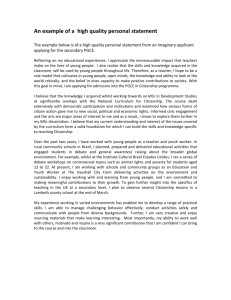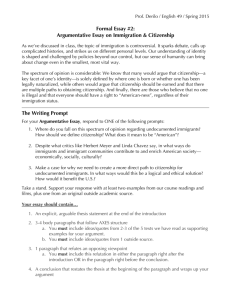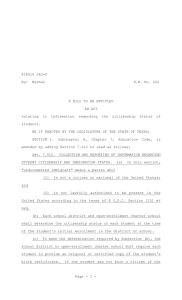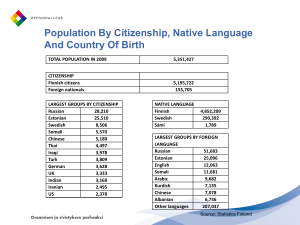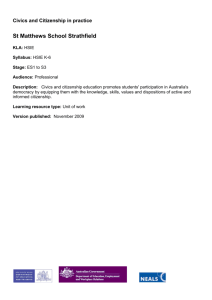CITIZENSHIP AND INTEGRATION: PRESENTATION TO THE RCM
advertisement
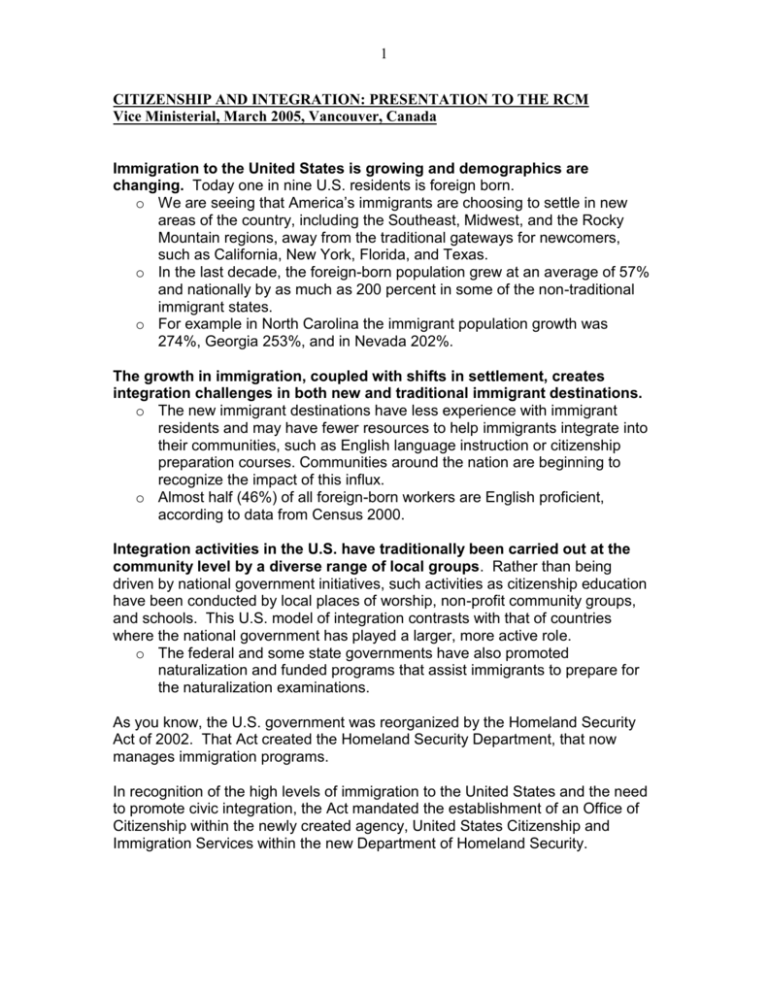
1
CITIZENSHIP AND INTEGRATION: PRESENTATION TO THE RCM
Vice Ministerial, March 2005, Vancouver, Canada
Immigration to the United States is growing and demographics are
changing. Today one in nine U.S. residents is foreign born.
o We are seeing that America’s immigrants are choosing to settle in new
areas of the country, including the Southeast, Midwest, and the Rocky
Mountain regions, away from the traditional gateways for newcomers,
such as California, New York, Florida, and Texas.
o In the last decade, the foreign-born population grew at an average of 57%
and nationally by as much as 200 percent in some of the non-traditional
immigrant states.
o For example in North Carolina the immigrant population growth was
274%, Georgia 253%, and in Nevada 202%.
The growth in immigration, coupled with shifts in settlement, creates
integration challenges in both new and traditional immigrant destinations.
o The new immigrant destinations have less experience with immigrant
residents and may have fewer resources to help immigrants integrate into
their communities, such as English language instruction or citizenship
preparation courses. Communities around the nation are beginning to
recognize the impact of this influx.
o Almost half (46%) of all foreign-born workers are English proficient,
according to data from Census 2000.
Integration activities in the U.S. have traditionally been carried out at the
community level by a diverse range of local groups. Rather than being
driven by national government initiatives, such activities as citizenship education
have been conducted by local places of worship, non-profit community groups,
and schools. This U.S. model of integration contrasts with that of countries
where the national government has played a larger, more active role.
o The federal and some state governments have also promoted
naturalization and funded programs that assist immigrants to prepare for
the naturalization examinations.
As you know, the U.S. government was reorganized by the Homeland Security
Act of 2002. That Act created the Homeland Security Department, that now
manages immigration programs.
In recognition of the high levels of immigration to the United States and the need
to promote civic integration, the Act mandated the establishment of an Office of
Citizenship within the newly created agency, United States Citizenship and
Immigration Services within the new Department of Homeland Security.
2
The objectives of the Office of Citizenship are to:
support the integration and participation of permanent residents in
American civic culture by enhancing informational and educational
opportunities
promote training on citizenship rights, privileges, and responsibilities
create citizenship-related ceremonies with greater meaning and stature
promotes instruction and training on citizenship rights and responsibilities,
o provides immigrants
To provide immigrants with the information and tools necessary to successfully
integrate into American civic culture.
o Materials for citizenship instruction are being updated and
standardized
o Access to the materials is being improved
The Office of Citizenship’s focus is on providing information and resources to
immigrants at two key points in their journey towards civic integration:
when they first become permanent residents, and
when they are ready and eligible to begin the formal naturalization
process.
This new Office of Citizenship is only two years old – the Department of
Homeland Security recently just celebrated its two-year anniversary. Let me tell
you about some of the Office’s accomplishments.
Last year, U.S. Citizenship and Immigration Services published and released an
orientation guide, Welcome to the United States: A Guide for New
Immigrants. {HOLD UP THE GUIDE}
o This comprehensive guide represents the first time that the federal
government has provided orientation materials for new permanent
residents.
o The guide contains practical information about daily life in the United
States and provides basic civics information that introduces new
immigrants to the system of government in the United States.
o The Office of Citizenship is translating the Guide into ten languages. The
Guide will be available for purchase and by download on the USCIS
website.
o The Office of Citizenship will employ a variety of marketing tools to
disseminate the guide nationwide. This will include radio and print
advertisements, distribution to community-based organizations, and
rollouts in local communities.
3
In addition, the Office of Citizenship is
o is developing materials for immigrants and educators that help prepare
immigrants for the naturalization exam.
o These materials include civics flash cards, a “100 Questions” Audio CD,
civics crossword puzzles, videos, workbooks, and CDs for use in teaching
civics and English as a Second Language.
The Office of Citizenship is also developing a “New Americans Almanac” that
will include information on United States history and biographical details about
prominent naturalized Americans.
The Office of Citizenship does not replace or compete with the communitybased organizations, but works with and through them. Direct interaction
with immigrants to promote citizenship and integration is still primarily at the local
level. U.S. Citizenship and Immigration Services has Community Liaison Officers
in 18 cities in the United States.
o These officers work to establish and maintain relationships with key
community stakeholders.
o They partner with and assist on-the-ground networks to carry out
integration activities.
o Maintain a regular dialogue with community and faith based organizations.
Through these on the ground relationships, useful information is provided
to our headquarters.
Given the long history the community-based organizations have with citizenship
programs, we went to them to learn.
In 2004, we conducted professionally facilitated focus groups in seven
communities across the United States. Through these gatherings, we
collected data on the perceived strengths and weaknesses of existing
immigrant integration services. The final report was released in September
2004.
The Office of Citizenship is also currently expanding partnerships and networks
at the federal, state, and local levels of government with the objective of creating
a continuous forum for the exchange of “Best Practices” on immigrant outreach
models and integration programs.
In September 2004, the Office of Citizenship held a one-day citizenship
symposium in Washington, DC featuring Secretary of Homeland Security Tom
Ridge. The symposium successfully promoted a national dialogue on the issue
of civic integration. Participants included academics, key representatives from
federal, state and local government, adult educators, community and faith-based
organizations, and the business community.
4
Increasingly, we are seeing State governments establishing offices to promote
citizenship and integration, especially in the States experiencing remarkable
rates of increase in their immigrant populations. For example, both Maryland and
Iowa have recently established such offices.
I think it important to note that the focus of our Office of Citizenship is on civic
integration, not economic. The objective is to integrate newcomers to the civic
values and constitutional principles of the United States, in other words to be
prepared to be a good American citizen, understanding and actively participating
in the political system. We believe that what makes the United States a
successful country of immigrants is that we subscribe to the same basic set of
values and principles.
Each year the United States proudly and enthusiastically welcomes hundreds of
thousands of new citizens through our naturalization process. The choice to
become a U.S. citizen is an important demonstration of one’s respect for the
institutions and people of the United States of America. U.S. citizenship is a
common bond that links people from diverse backgrounds and cultures.

